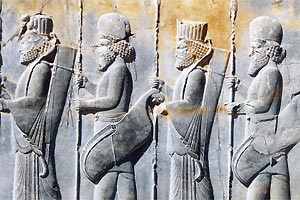Darius I made his empire the most organised that the world had known. In order to administer it, he divided it into 20 provinces called Satrapies, administrated by a Satrap or governor.
The subdued peoples were neither massacred nor exiled and conquered cities were not razed, as they had been by the Assyrians. The Persians were benevolent with their enemies. In fact, Cyrus II, upon conquering Babylon, freed the previously enslaved Israelites, who could then return to Palestine.
Harsh repression was exercised only in Egypt, which had to be repeatedly conquered.
Subdued populations could retain their customs and local governments. They became provinces of the Empire and only had to pay tribute, fixed by the monarch according to their resources so as to avoid impoverishment.
Taxes, from which only Persians were exempt, were paid in gold, silver, precious stones and spices.
The Satrap was in charge of collecting tributes and controlling local political communities. Three officials assisted him: a treasurer, a secretary and a troop commander.
A kind of spy network was created, often regarded as the first secret police. They were inspectors and received the title «the eyes and ears of the King». Their mission was to verify whether provinces could pay the tribute that had been set for them, and to warn the king of any rebellions or disobedience. They paid surprise visits to the provinces to examine the Satrap’s rule, as it was common that double the set tribute was charged and that Satraps kept the difference for themselves. Besides this, the fact that satraps could develop their own policies threatened the unity of the empire.
Following the model of the Lydian Kings, Darius I ordered a single coin to be minted and adopted it as the system of payment throughout the Empire.
Great constructions
Susa, east of the Tigris in Mesopotamia enjoying milder winters than Pasgardae, the original residence of the king, was the administrative centre and official capital of the empire before the construction of Persepolis.
Darius I had a winter palace built in Susa, and all the peoples of the empire took part in its construction. Babylonians built the bricks, Syrians brought cedar from Lebanon and Egyptians carved the wood. Gold came from Lydia and Bactria; lapis lazuli, carnelian and turquoise from Sogdiana and Chorasmia (currently Russian Turkistan); wall decorations from Ionia and ivory from India.
Darius I ordered the construction of the ceremonial city of Parsa or Persepolis (its Greek name). Building started around 520 B.C. in South-western Iran on a plateau of around 13 hectares.
It was later expanded by his son Xerxes I and his grandson Artaxerxes I. No temples were built, as Persians were content with altars for their gods. They did have many palaces, because every King had one constructed for himself. The great halls of columns were inspired by Egyptian temples. The brick walls, of great proportions, were hollow inside and stone outside.
Persepolis was used once a year during the New Year ceremonies, the Naruz, in the spring equinox. During these celebrations, ambassadors from the entire empire presented their offerings to the king in the Apadana, a spacious audience hall.
In order to unite the empire which was 4.500km long and 800 to 2.500km wide, a vast network of roads was built, and patrolled by soldiers to protect merchants. The King’s couriers galloped through these roads, changing horses every 15 km. These jockeys covered the 2500km length of the royal route in a week.
Trade
Merchants calmly travelled these roads from east to west and vice versa. The chicken was domesticated in India and Iran and sold by the Persians in the Greek cities of Asia Minor, from where it was introduced into Europe. Roses, jasmines, lilies, narcissus, peaches, oranges, asparagus and spinach were introduced in the same way. All these words stem from Persian.
Religion
Persians worshipped a complex pantheon headed by the king of the gods, Ormazd or Ahura Mazda. In the 6th Century B.C., Zoroaster reformed the cult and made it monotheistic. Ahura Mazda became the only god, creator of the Universe, lord of purity, wisdom and truth.
According to the prophet, people have to decide whom they follow, but good eventually triumphs. A person will only enter the «kingdom of light» if they have kept their body and soul pure. As has already been mentioned, Persians did not build temples but altars with fires which burnt day and night. The priests in charge of watching over the sacred fire came from a tribe called the Magi and were remarkable astrologers and astronomers.
The Army
The Achaemenid took in a large number of recruits from the empire’s provinces and each soldier wore the traditional clothing and used the traditional weapons of his region, but all officials were Persians or Medes. Its main strength was the Persian cavalry and, above all, the Royal Guard, known as the «Ten Thousand Immortals.»
This guard was composed of archers and pikemen and was named «the Immortals» because their number was always the same. If one of them was injured or died he was immediately replaced by another.
The Persians kept the peace within their dominion for 200 years. However, with such an extensive empire and heterogeneous army they could not remain united forever. For this reason the most distant provinces began to rebel, such as continuously occurred in Egypt.








 Muere Evita
Muere Evita